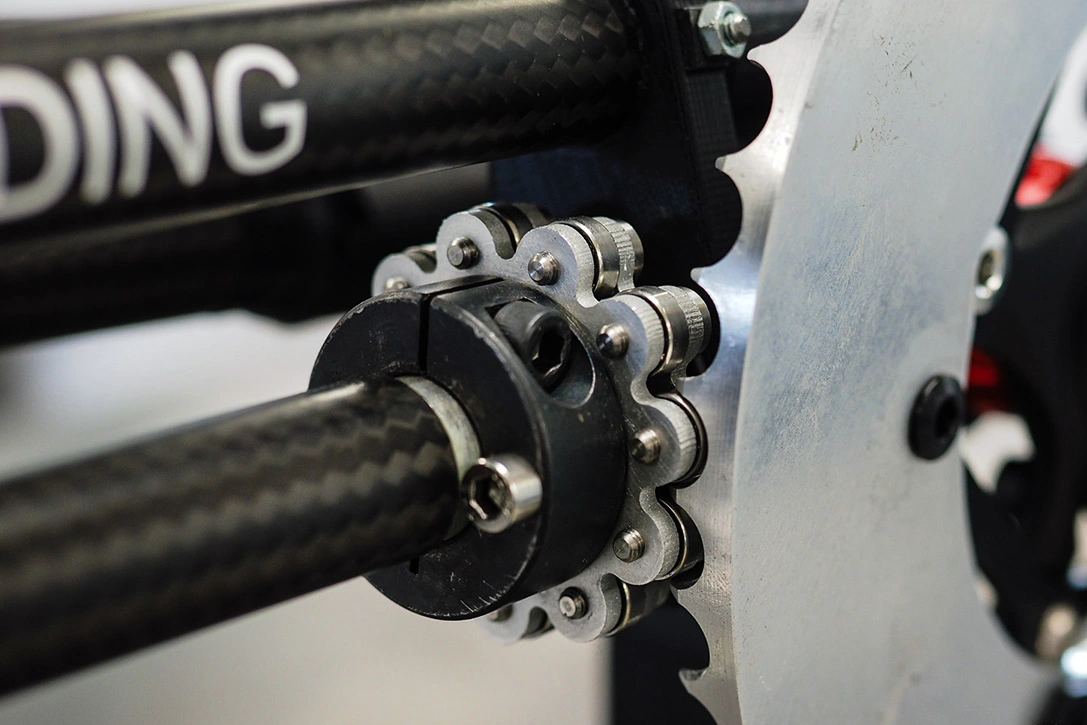
Breaking the Chain: The Power of Data-Driven Innovation
In 2018, the cycling community was taken by surprise. During the Eurobike trade show in Friedrichshafen, a city located in southern Germany, an extraordinary bicycle made its debut on stage—one that was devoid of a chain, a derailleur, and the conventional mechanical components that had characterized bicycles for more than a hundred years.
The creators? A partnership between Danish company CeramicSpeed and the University of Colorado’s Mechanical Engineering Department. Their mission? To design the most efficient cycling drivetrain possible. The result was something they called Driven, a revolutionary system that replaced the conventional bicycle chain-and-gear mechanism with a set of sprocket-style shafts running on 21 high-performance ceramic bearings.
The impact? A drivetrain that reduced friction by 49% compared to the best chain-and-derailleur setups in the market, eliminating eight points of sliding friction. In other words, a more efficient, faster, and smoother ride; all because someone dared to challenge the way bicycles had always been built.
But what does this have to do with business intelligence (BI) and data analytics? Everything.
In the same way that CeramicSpeed looked beyond the traditional mechanics of cycling, organizations must break the chain of outdated BI and analytics practices to unlock innovation. This article explores three types of innovation that are possible only when businesses embrace a data strategy that thinks outside the box — just like the inventors of this incredible bike.
1. Efficiency Innovation: Simplifying Instead of Stalling
The key to efficiency innovation is simplifying. Just like the CeramicSpeed drivetrain reduced friction and streamlined energy transfer, effective BI systems focus on removing unnecessary steps, data friction, and bottlenecks. The goal: simplify processes so that data flows more smoothly, enabling businesses to gain insights more rapidly. This streamlining is crucial as it eliminates obstacles that prevent data from reaching decision-makers, fostering more agile and efficient operations.
For the Driven drivetrain, the primary benefit of its simplification was the significant decrease in friction. Less wasted energy meant better performance and efficiency. In the same way, an innovative BI and analytics strategy should be focused on reducing data friction, the unnecessary complexity, inefficiencies, and bottlenecks that slow decision-making.
As Aaron Walker, Data Management Consultant at IData put it in his article on data friction: “In the modern enterprise, data needs to flow smoothly so that it gets to the right users at the right time, in a usable format. But there are any number of places where things rub against data, so to speak, preventing its efficient flow and timely usage.”
That’s exactly the problem many organizations face with their data ecosystems. Data friction, caused by bottlenecks, outdated processes, and unnecessary complexity, slows down decision-making and prevents analytics from delivering real value. Whether it’s rigid approval chains, fragmented data sources, or clunky reporting mechanisms, inefficiencies in data flow make it harder for businesses to get insights right when they need them.

Just like the Driven drivetrain reimagined cycling efficiency, a well-designed business intelligence strategy removes unnecessary friction, simplifies cumbersome processes, and ensures data moves seamlessly to the decision-makers who need it most. Traditional BI systems, however, are often bogged down by rigid, siloed architectures. Data must be extracted, transformed, loaded, and processed through multiple layers before it’s useful. By the time insights reach decision-makers, they’re often stale, thus creating drag on progress, much like, well, an old, rusted bicycle chain.
Forward-thinking companies are removing the chain by embracing modern data fabric architectures, real-time analytics, and AI-driven automation:
- Cloud-based analytics eliminate data silos and enable real-time access to insights.
- Augmented analytics automate data discovery, reducing the need for manual reporting.
- Self-service BI tools empower users to access data without IT bottlenecks.
Simplifying data processes enables businesses to eliminate friction, increase speed, and free up valuable resources to focus on innovation instead of maintenance. Just as the Driven drivetrain removed unnecessary points of contact, streamlining BI allows insights to flow seamlessly, propelling the organization forward.
2. Transformational Innovation: Unifying for a Stronger Foundation.
In the world of transformational innovation, it’s all about unifying disparate data systems into a cohesive whole. Think of it as rebuilding your organization’s data infrastructure, much like replacing a bike’s chain with a more efficient, modern alternative. Unifying is key because it allows organizations to create an integrated, seamless system where data is consistent, accessible, and fully leveraged across departments.
The Driven drivetrain went way beyond just a slight improvement over traditional chains to completely reimagine how bicycles could work. It didn’t tweak the existing system; it replaced it entirely with a more efficient alternative.
This kind of radical thinking is exactly what data-driven organizations must embrace to drive transformational innovation. Making slight improvements to outdated processes won’t cut it these days; companies that want to be innovative need to be willing to rewrite the rules. In legacy BI systems, organizations often patch over inefficiencies with temporary fixes, leading to a patchwork of tools and siloed solutions. But true transformation requires a unified data strategy; one that doesn’t just smooth over existing flaws but eliminates them entirely by rethinking the way data is structured, stored, and accessed.
Consider how businesses like Netflix, Uber, and Amazon changed entire industries:
- Netflix didn’t just make Blockbuster-style rentals more convenient; it redefined entertainment through streaming.
- Uber didn’t just improve taxis; it transformed transportation with a decentralized, app-based model.
- Amazon didn’t just optimize retail; it pioneered data-driven logistics, AI-powered recommendations, and cloud computing.
Each of these companies didn’t settle for adding a few gears to an old system; they scrapped the entire drivetrain and built something better. In the same way, companies must rethink their BI and analytics approach. Organizations should not expect significant changes merely by adding new analytics tools to their current outdated systems. It is essential to integrate data into a modern, scalable architecture that facilitates real-time insights, encourages cross-functional collaboration, and supports predictive intelligence.
For businesses, this approach involves leveraging data analytics to fundamentally rethink their products, services, and customer experiences. This could involve:
- AI-powered personalization that predicts customer needs before they arise.
- Digital twins that simulate business scenarios for better decision-making.
- Predictive analytics that shift companies from reactive to proactive strategies.
By rebuilding from the ground up instead of merely refining old methods, companies can leap ahead of competitors and create game-changing innovations. Just as Driven replaced the old mechanical structure of cycling, rebuilding BI strategies enables businesses to operate at an entirely new level; a unified level where data is no longer just an asset but the foundation of a company’s innovation strategy.

3. Competitive Innovation: Amplifying to Stay Ahead
Competitive innovation is all about amplifying; that is, boosting the power of your data analytics to outperform rivals. Businesses must enhance their data strategies to maintain a competitive edge, just as cyclists strive to gain every possible edge to surge ahead of their rivals. Amplifying your analytics involves expanding capabilities, automating decision-making processes, and leveraging data to swiftly identify and seize opportunities before competitors do.
The Driven drivetrain exemplifies this principle by establishing a new standard for efficiency. This standard eliminated unnecessary friction, thus providing a significant advantage over conventional bicycles.
Organizations that implement advanced business intelligence and analytics strategies not only maintain their competitive edge but also transform data into a valuable asset. Companies gain deeper insights, increase agility, and make quicker, more informed decisions when they improve upon (or “amplify”) their analytics capabilities.
Consider two companies vying for dominance in the same market:
• Company A uses traditional BI dashboards to track key performance indicators (KPIs). Reports are generated weekly.
• Company B uses real-time analytics, AI-driven insights, and automated decision-making. They anticipate problems before they happen, personalize customer interactions dynamically, and optimize pricing in real time.
Which company do you think wins the race?
The ability to extract deeper insights, act faster, and personalize experiences gives businesses a decisive edge. Consider:
• Retailers that use AI-driven demand forecasting to optimize inventory, preventing stockouts and overstocking.
• Financial institutions that deploy real-time fraud detection, stopping security threats before they escalate.
• Manufacturers that leverage IoT-powered predictive maintenance, reducing downtime and costs.
Businesses drive change rather than just reacting to it when they amplify their use of BI. They create new opportunities, outmaneuver competitors, and set the standard for innovation. Just as the Driven drivetrain redefined cycling with unprecedented speed and efficiency, an amplified BI strategy propels companies to the front of the pack—where leaders belong.

Breaking the Chain: The Data-Driven Future (Conclusion)
Innovation in business intelligence and analytics goes beyond mere adaptation; it’s about liberation. The most thriving companies will be those that defy traditional norms, utilize data in innovative manners, and envision new possibilities. What does this entail?
- Simplifying operations by removing data obstacles allows organizations to make quicker, more informed choices.
- Unifying systems and dismantling barriers fosters a unified, fluid data environment, ensuring consistent and accessible information across all sectors.
- Amplifying insights by enhancing data capabilities helps businesses act more strategically and stay ahead of the competition.
When your data moves smoothly and efficiently, you are paving the way for simplifying operations and enabling faster, more accurate decision-making. By unifying your analytics across different systems and teams, you establish a cohesive environment where data is consistently utilized to achieve outstanding outcomes. If your competitors are still dependent on outdated systems, you can amplify your edge by responding more quickly, intelligently, and proactively.
In a world where businesses must continually adapt and evolve, simplifying, unifying, and amplifying your data strategy will help you lead the way, not follow. Like the innovators behind CeramicSpeed’s Driven system, companies that rethink their approach to data (and don’t settle for traditional solutions) will create groundbreaking, competitive advantages.
So, the question is: Are you still riding with a chain, or are you ready to break free?
It’s time to innovate. It’s time to simplify, unify, and amplify. It’s time to rethink data.

 - by
- by





